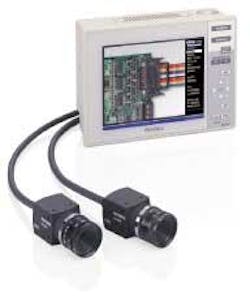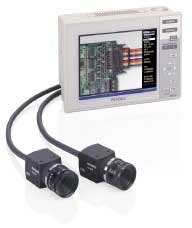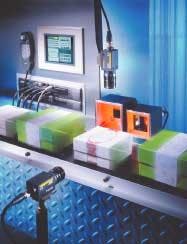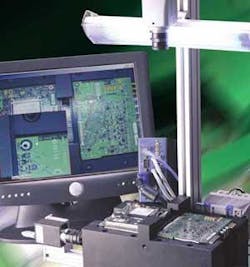Machine vision targets industrial automation
System developers are offering PC-based functionality and user-friendly data acquisition, motion control, and image-processing hardware and software.
By Andrew Wilson, Editor
Better, cheaper, and faster has always been the creed of the computer industry. Today's laptop PC sports a 2.4-GHz processor; a 60-Gbyte drive; embedded USB, FireWire, serial, and parallel interfaces; and an XVGA output—all for less than $3000. Mirroring these advances, machine-vision developers are offering systems within a similar price range that include PC-based hardware functionality coupled with user-friendly data acquisition, motion control, and image-processing software.
Choosing such a machine-vision system, however, is not as easy as determining whether to buy a Gateway or a Dell PC. Of the many machine-vision systems currently available, several use proprietary camera interfaces, embedded "point-and-click software," and embedded RISC processors, DSPs, and CPUs that run on standard or embedded real-time operating systems that cannot be programmed using open-standard programming techniques such as Visual C++.
Price and performance
The reasons, says Dan Holste of Banner Engineering (Minneapolis, MN, USA), include ease of use, performance, and price. These factors, he argues, encourage the development of integrated systems that free the developer from the programming complexity of machine-vision algorithms. At the same time, such systems can be relatively easily deployed to perform a large percentage of machine-vision tasks, such as parts measurement and inspection. And the cost of such products is relatively low compared with introducing bus-based camera, frame grabber, and PC-hosted systems.
Indeed, Banner's latest system offering, Presence Plus Pro, costs $2295, including a camera tethered to a PowerPC-based vision engine running the company's menu-driven machine-vision software. Set up using a remote PC over either a serial or Ethernet interface, Presence Plus Pro features a pluggable terminal block that accommodates PNP/NPN-configurable inputs and outputs and stores inspection data.
"Rather than approach the design of the product from a machine-vision perspective," Holste says, "Banner's aim was to make a programmable smart sensor that uses vision." Therefore, while other companies offer systems that feature a number of toolsets that are frequently expanded, Banner's philosophy is to provide a system that uses a point-and-click set-up menu that allows the developer to install the camera, illuminate the target, and select the features to be analyzed.
Keyence (Woodcliff Lake, NJ, USA) also offers a machine-vision system that incorporates cameras, processors, and proprietary vision software. The CV-701 system can be configured with a number of color or gray-scale cameras, serial RS-232, and I/O controllers (see Fig. 1). "Keeping the camera separate from the host vision processor allows other options to be added as required," says Joshua Jelonek, Keyence technical support engineer. In the future, this system will include Ethernet support and upgraded software for plus-or-minus pixel repeatability, statistical processing, and the ability to view images over installed networks.
Both the series A100 and A200 devices from Matsushita Electric Works (Holzkirchen, Germany) bridge the performance gap between intelligent cameras and PC-based systems. The A200 standard configuration allows the connection of two cameras and can process two images in parallel. Matsushita's Multichecker software allows tasks such as presence, measurement, positioning, sample comparison, or type identification to be programmed from a set-up menu. According to the company, a total of 64 different programs with almost 300 checkers produce almost 19,000 test options.
Embedded software
By targeting the industrial-automation market, companies such as Banner, Keyence, and Matsushita all offer developers a number of ways for their products to communicate with multiple I/Os and serial and parallel interfaces. However, while many available low-cost vision systems can solve simple vision tasks, some companies are tackling more-complex tasks with embedded software that includes more vision-specific algorithms such as geometric pattern-matching.
First to offer such a tool in its line of vision sensors is Cognex Corp. (Natick, MA, USA). Its PC-based vision system PatFind is a part-location tool based on the company's PatMax technology. It can locate objects when they vary in size or orientation, when their appearance is degraded, or when they are partially hidden from view. By offering the algorithm as part of its In-Sight 3000 vision sensor, the company has developed a product that features dual processors for vision and networking and that embeds lighting control, built-in discrete I/O, and a VGA display output.
To program the device, developers use a vision spreadsheet that enables the selection of tools and parameters from drop-down menus and then automatically inserts tool results into spreadsheet cells. These data can be linked, enabling applications to be modified while the image of the part remains visible during setup.
Parts or features located at random angles and positions that must be inspected at speeds up to 6000 parts per minute are the target of the F250 machine-vision sensor from Omron (Schaumburg, IL, USA). The $12,000, four-camera machine-vision sensor can be used for multi-angle applications and provides rotational position compensation through Omron's edge-code technology (see Fig. 2).
The Omron Quest optical-character-recognition (OCR) and verification algorithm can detect printed alphanumeric characters using built-in character libraries that can discern multiple characters. The F250 also features a fine-matching algorithm that detects differences between the registered model and the image being measured. This model-matching algorithm reveals defects on printed labels and graphic patterns. The F250-based cameras can be fitted with several light sources, including those that support Omron's Intelligent Light Source and Intelligent Light Source LED options from CCS America (Waltham, MA, USA).
Programmable machines
While industrial-automation companies such as Omron are making their mark in the machine-vision marketplace, established machine-vision companies such as Coreco Imaging ipd Division (Billerica, MA, USA), Matrox Imaging (Dorval, QC, Canada), and National Instruments (Austin, TX, USA) are leveraging their software and hardware expertise in a number of low-cost programmable machine-vision systems.
The ipd NetSight is a preconfigured vision system equipped with the com-pany's Sherlock software that enables developers to build vision applications without having to write code or use MVTools—a library of machine-vision and pattern-finding tools. Using NetSight, a number of analog, digital, and Camera Link cameras can be interfaced to the system. Industrial-interface controls include isolated inputs/outputs, trigger, strobe, and Ethernet.
According to Steve Geraghty, director of operations at ipd, the next generation of NetSight products will be Pentium-based systems that add more hardware capability to quantify results of image analysis and increased I/O capability. "What we are looking to do," says Geraghty, "is to offer a machine-vision system with combined PLC capability."
This month, National Instruments (NI) enters the low-cost machine-vision-system market. Announced at the recent International Robots & Vision Show, the NI 1454 Compact Vision System (CVS) extends the power of the company's LabVIEW software into low-cost, rugged, machine-vision applications (see Fig. 3). The CVS features three IEEE 1394 (FireWire) ports for connectivity to imaging sensors from Sony Electronics (Park Ridge, NJ, USA), Basler (Ahrensburg, Germany), and other vendors.
Developers have two software options for application development on the NI CVS-1454. NI Vision Builder for Automated Inspection is an interactive software environment that simplifies the task of developing inspection systems. Developers use a point-and-click interface to build applications for the CVS hardware. In addition, developers can use the LabVIEW graphical development environment to create custom vision applications. The LabVIEW code-generation feature in Vision Builder gives developers the power to migrate between these two software programs.
The CVS integrated I/O architecture delivers 15 digital input lines, 14 digital output lines, and RS-232 and Ethernet connectivity to more than 20 of the company's FieldPoint family of distributed I/O measurement modules. Developers also can use the RS-232 and Ethernet connections to communicate with PLC and motion-control devices and to link the NI CVS-1454 vision system and the data it collects to an Ethernet network. In addition, a VGA connection allows inspection results to be monitored in real time.
The Matrox 4Sight-II machine-vision system harnesses the power of the company's MIL software-development toolkit. To allow systems developers to tailor their systems to meet a variety of applications, Matrox has taken an open-systems approach in the design of its 4Sight-II. The self-contained vision system based around the PC-104+ form factor can be configured with different modules to perform mage capture, processing, and display; networking; and general-purpose I/Os. These modules include optional frame-grabber boards for monochrome, component RGB, LVDS, and Camera Link cameras.
"OEMs expect the flexibility of open systems," says Pierantonio Boriero, Matrox product manager. "While some vendors are focusing on professional end users with no programming backgrounds, the modular 4Sight-II is targeted directly at systems developers."
Smart cameras
Companies such as Cognex, Matrox, ipd, and National Instruments have decided to leverage their software in a number of hardware offerings that include frame grabbers and low-cost machine-vision systems. In this way, they can offer several products while preserving the designer's investment in the company's software.
Interestingly, this concept also has been adopted by other vendors wanting to leverage their software into smart-camera products. Cognex, for example, offers a library of image-processing and gray-scale analysis tools, including PatFind, with its In-Sight series of vision sensors. And FrameWork software from DVT Corp. (Duluth, GA, USA) is a Windows-based program that includes tools such as OCR, object finding, and scripting that is shipped free with the company's SmartImage sensors. According to DVT president Phil Heil, the company will soon announce Version 2.6 of FrameWork software that will include support for the Extensible Markup Language, which allows data from such image sensors to be encoded and transmitted across Ethernet networks.
"Many systems integrators using machine-vision sensors in their systems are still facing customer demand to see images as they are being processed," says Heil, "although, often, images are inspected faster than the human eye can see them on the monitor." Accordingly, DVT introduced its SmartLink product, an embedded PowerPC-based controller that allows multiple outputs from SmartImage sensors to be viewed from a single location. Using this product, developers also can store failed images on plant networks via Fieldbus or TCP/IP Ethernet for later review and analysis. According to Heil, the SmartLink product will soon add touchscreen support, access to start/stop functions, and diagnostics.
Multiple platforms
General-purpose machine-vision-software vendors are also looking at porting their software to a number of smart cameras, frame grabbers, and host computers. Recently, Stemmer Imaging (Puchheim, Germany) released Version 8.0.1 of its Common Vision Blox image-processing library. In addition to running on host PCs, supported hardware for image capture now includes drivers for the MicroEnable III frame grabber from Silicon Software (Mannheim, Germany) and for the PC2-Vision frame grabber from Coreco Imaging (St.-Laurent, QC, Canada). In addition, Stemmer has added a driver for FireWire cameras that allows images to be captured over OCHI-compatible IEEE adapters that are standard features of many laptops and computers.
The ThinkEye smart camera from JAI (Glostrup, Denmark) also runs a basic version that includes Image Manager and three Common Vision Blox tools. The camera's user interface, iTuition, has been optimized to include code completion, extended drag-and-drop functionality, and simpler script debugging.
NeuroCheck (Remseck, Germany) offers its machine-vision software on a number of platforms that include its NeuroCheck-Compact—a "processor camera" that integrates a PC, CCD camera, and NeuroCheck image-processing software. Additional 24-V digital inputs and outputs and a LAN interface allow the camera to be integrated with PLCs and to be remotely controlled by networked Object Linking and Embedding clients.
In many respects, the progression of machine-vision systems is following that of the desktop PC. Smaller, modular systems will eventually swallow PLC, extended I/O, multiple camera, and point-and-click software development functionality in systems costing less than $2000. For systems integrators, the most important factors in choosing such systems are ease of use, performance, price, and return on investment. For developers installing multiple systems, further considerations must include the software learning curve and whether the vendors support a number of products at different price points that will meet the demands of networked systems.
Company Info
Banner Engineering www.bannerengineering.com
Basler Vision Components www.basler-vc.com
CCS America www.ccs-inc.co.jp
Cognex www.cognex.com
Coreco Imaging ipd Division www.goipd.com
DVT Corp. www.dvtsensors.com
JAI www.jai.com
Keyence www.keyence.com
Matrox Imaging www.matrox.com/imaging
Matsushita Electric Works www.mew-europe.com
National Instruments www.ni.com
NeuroCheck www.neurocheck.com
Omron www.omron.com
Silicon Software www.silicon-software.com
Sony Electronics www.sony.com/videocameras
Stemmer Imaging www.stemmer-imaging.de



